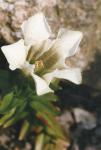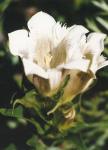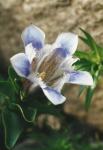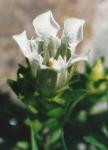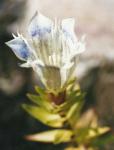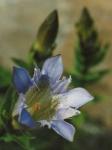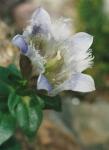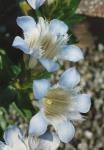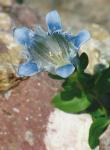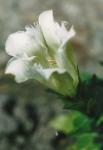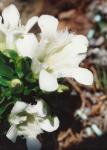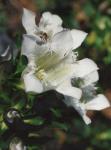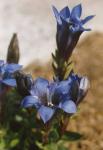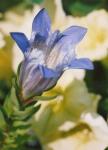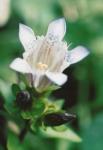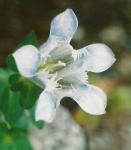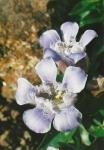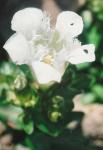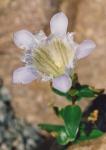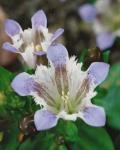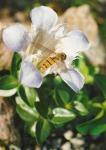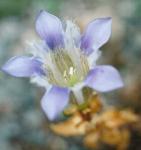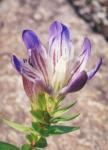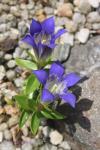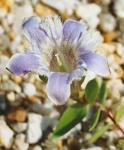Zur Entstehung von Pflanze und Bezeichnung
"Gentiana x gelisepta"
Häufig werde ich gefragt: "Was ist 'Gentiana x gelisepta'; die Bezeichnung findet man in keiner Fachliteratur, keinem Nach- schlagewerk - nur Du bzw. ein, zwei andere Pflanzenfreunde verwenden sie". Daher sei es mir gestattet, auf diesem Weg anläßlich der sehr umfangreichen Erweiterung und Neugestal- tung dieser Website allen Pflanzenfreunden eine Erklärung wie auch Erläuterungen dazu abgeben zu dürfen.
Hinter dem Namen verbirgt sich eine von mir so genannte Na- turkreuzung, welche bei einem bekannten Pflanzenfreund aus den Arten Gentiana gelida (gelb) und Gentiana septemfida (blau) entstand, welche er in ziemlich relativer Nähe zueinander pflanzte. Eines Tages "verabschiedete" sich aber G. gelida - jedoch liefen an jener Stelle viele Sämlinge auf, welche später zwar hauptsächlich im verschiedensten Blau - aber auch in jenen außergewöhnlich unbeschreiblichen Farb- tönen blühten, wobei die weißen und gelblichen Formen zwangs- läufig mehr Gentiana gelida-Gene erhielten.
Jene wundervollen Formen können nur über Aussaat erhalten werden, wobei es auch hier viele Unterschiede im Habitus gibt und es kaum möglich ist, zwei zu 100% gleiche Pflanzen zu bekommen. Wenn schon die Färbung der Außenkelch-Streifung "in etwa" gleich ist, gibt es sicher einen feinen Unterschied (heller oder dunkler) in der Blütenfärbung - bzw. umgekehrt! Außerdem sind unterschiedliche Wuchsformen existent: kräfti- gere robustere; die anderen zierlicher - und heikler; wobei die weißen, gelblichen und rot-rötlich-violetten Formen - nach meiner Erfahrung - leider zu den letzteren gehören... Dann gibt es höher- und kompakt wachsende bzw. Pflanzen mit straff aufrecht wie niederliegenden Stengeln, welche wiederum auch unterschiedlich gefärbt sind und unterschiedlich viel Blüten tragen können. Weiters kann es verschieden größere bzw. kleinere oder längliche bzw. breitere Blattformen inner- halb von Pflanzen mit einer "fast" gleichen Blütenfarbe geben. Zudem beginnen die Formen nicht unmittelbar zum gleichen Zeitpunkt zu blühen. Leider gestaltet sich ihre vegetative Ver- mehrung (kleine Pfahlwurzel) über Schnitt- bzw. Triebsteck- linge (kaum Wurzelbildung) als Problem...
Die Bezeichnung "Gentiana x gelisepta" stellt somit eine Art- namen-Kombination der Vorsilbe von G. "geli-da" und der Kurzform von "sept-emfid-a" dar - botanisch klangvoll zu- sammengezogen. Ob dies - wie ich glaube - botanisch korrekt oder erlaubt bzw. vertretbar ist, mögen ausgewiese Fachleute und Botaniker beurteilen.
Alle einmal bei mir existenten Formen habe ich nachfolgend im Foto festgehalten, wobei als "Unterbild" immer auch die Kelch- aufnahme der jeweiligen Blüte zu sehen und somit die Möglich- keit gegeben ist, die vielmals nur geringen Unterschiede von einem Typ zum anderen festzustellen; von einigen existieren auch schöne Tuff-Auf-nahmen. Bei Doppelclick auf das jewei- lige Foto gibt es dies in "Großformat"!
Die im letzten Foto unter dem Arbeitstitel "G. x asclepiasepta" gezeigte Pflanze ist ein Sämling von Gentiana asclepiadea 'Rosea'. Vermutlich sind die Blüten durch Bienen und andere Insekten bestäubt wurden, sodaß ihre Gene dermaßen verän- dert wurden, daß ALLE aufgelaufenen Sämlinge mit dem Habitus von G. asclepiadea 'Rosea' genausoviel zum Tun haben wie Pfingsten mit Weihnachten und Ostern zusammen und ALLE die Wuchsform jener "geliseptas" aufweisen!
Da halt die Saat von eben jenem G. asclepiadea stammte, hab ich auch hier (zunächst) aus Teilen beider Artnamen eine Kombination erstellt. Jedoch gab es außer der gezeigten Pflanze, welche zumindest eine "ansprechende" Kelch-Außen- färbung mit einem schwachen Rosa-Hauch zwischen den Zipfeln und Weiß-Anteil im Blütenblatt herzeigen kann, keine exclu- siven "exotischen Farbspritzer" - und somit leider auch keinen "Gentiana x gelisepta 'Rosea'RB"... (Bis jetzt...)
Stollberg, 22.03.2012
On the origin of plant and designation "Gentiana x gelisepta"
Frequently, I am asked: "What is 'Gentiana x gelisepta', the name is not found in any literature, not a reference book - only you or one or two other plant friends use it." Therefore, I would like to be allowed to make a declaration as well as explanations for this to the plant friends on the occasion of the very extensive extension and redesign of this website.
Behind the name there is a so-called natural cross, which was formed by a well-known plant friend from the species Gentiana gelida (yellow) and Gentiana septemfida (blue), which he planted in relatively close proximity to each other. One day, however, G. gelida departed, but many seedlings flourished at this point, which later flourished mainly in the most varied blue colors, but also in their extraordinarily indescribable color shades, with the white and yellow forms inevitably having more genes - tiana gelida genes.
These miraculous forms can only be obtained by sowing, although there are many differences in the habit, and it is scarcely possible to obtain 2 to 100% of the same plants. If the staining of the outer-girdle stripe is "roughly equal", there is certainly a subtle difference (lighter or darker) in the flowering - or vice versa! In addition, different forms of growth exist: more robust; the others more delicate - and delicate; the white, yellowish, and reddish-reddish-violet forms-unfortunately, according to my experience - belong to the latter.... Then there are higher and more compactly growing plants with taut erect like stems, Are dyed differently and can carry different flowers. Furthermore, there may be differently larger or smaller or elongate or broader leaf forms within plants with an "almost" same flower color. Moreover, the molds do not begin to bloom immediately at the same time. Unfortunately, their vegetative multiplication (small pile roots) is caused by cut or shoots (hardly root formation) as a problem...
The term "Gentiana x gelisepta" thus represents a combination of the prefix of G. "geli-da" and the short form of "sept-emfid-a" - botanically soundly combined. Whether, as I believe, this is botanically correct or permissible or acceptable, may be judged by experts and botanists.
All of my existing forms I have captured in the photo below, whereby the celestial image of the particular flower is always to be seen as a "subpicture", and thus the possibility of determining the only small differences from one type to another is possible; Some of them also have beautiful tuff recordings. For doubleclick on the respective photo, there is this in "large format"!
The plant shown in the last photo under the working title "G. x asclepiasepta" is a seedling of Gentiana asclepiadea 'Rosea'. Presumably, the flowers are pollinated by bees and other insects so that their genes have been altered so that ALL the seedlings with the habit of G. asclepiadea 'Rosea' have genausoviel to do like Pentecost with Christmas and Easter together and ALL the growth form of those " Yellowiseptas "!
Since the seed of the same G. asclepiadea came from, I have also here (initially) from parts of both kind names a combination created. However, apart from the plant shown, which can at least produce an "appealing" cup-shaped outer color with a weak pink hint between the lobes and the white portion in the petal, there were no exclusive "exotic color splashes" no "Gentiana x gelisepta 'Rosea'RB" ... (Until now ...)
Stollberg, 22.03.2012
